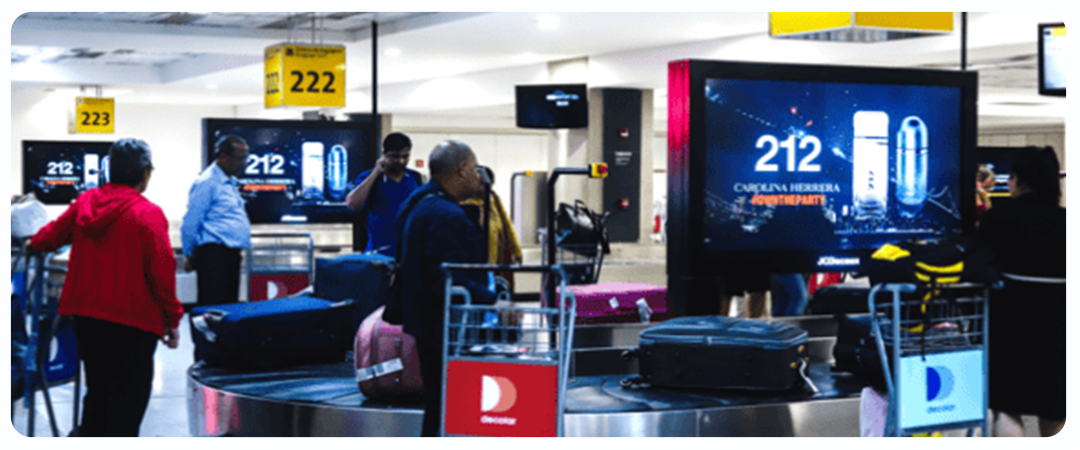
Brazil's airports are bustling gateways, not just for tourism, but significantly for commerce, investment, and high-level business travel. For marketers aiming to capture the attention of decision-makers and affluent individuals, understanding the nuances of publicidade em aeroportos (airport advertising) is paramount. This environment offers unparalleled opportunities to engage a captive, high-value audience during moments of high dwell time and receptivity. Effectively leveraging mídia aeroportuária (airport media) requires a strategic approach, focusing on prime locations within the country's key aviation hubs.
Brazil's Premier Airport Hubs: Where Business Takes Flight
To effectively target the desired demographic, we must focus on Brazil's top five airports, which handle the lion's share of domestic and international business traffic. These typically include São Paulo/Guarulhos (GRU), São Paulo/Congonhas (CGH), Brasília (BSB), Rio de Janeiro/Galeão (GIG), and Rio de Janeiro/Santos Dumont (SDU). Each airport has a unique profile: GRU is the primary international gateway, CGH and SDU are crucial for the high-frequency Rio-São Paulo business shuttle ("ponte aérea"), GIG serves international and domestic routes, and BSB is the hub for governmental and related business travel. Understanding passenger flow and purpose within these hubs is key to successful marketing em aeroportos.
Top 10 High-Impact Airport Locations in Brazil
Pinpointing the most effective locations requires looking beyond sheer passenger numbers and considering the quality of exposure and relevance to our target audience. Based on typical travel patterns of business leaders and affluent individuals, here are ten strategic zones across Brazil's top airports where your message can achieve maximum impact:
- GRU - International Departures (Premium Check-in & Security): High concentration of international business travelers and affluent individuals. Digital and high-impact static formats near airline lounges and premium check-in counters offer excellent visibility.
- GRU - International Arrivals (Baggage Claim & Customs): A key intercept point post-flight. Large format digital screens or static displays near baggage carousels for premium cabin flights ensure visibility during wait times.
- CGH - Main Departures Concourse: As the heart of the Rio-São Paulo air bridge, this area sees constant C-suite and business traffic. Large digital screens (painel digital publicidade aeroporto) dominate this space.
- CGH - Boarding Gate Areas (Key Business Routes): Targeting specific gates serving major business destinations like Rio de Janeiro, Brasília, or Belo Horizonte allows for focused messaging.
- SDU - Departures Lounge: Similar to CGH, SDU caters heavily to the Rio-São Paulo business traveler. The main departure waiting area offers significant dwell time.
- BSB - Main Concourse (Departures/Arrivals): Brasília's airport serves government officials, lobbyists, and national business leaders. High-visibility placements in the central circulation areas are crucial.
- GIG - International Terminal (Duty-Free Approaches): Targeting travelers before or after they visit duty-free shops captures both business and affluent leisure travelers.
- GRU - Domestic Business Class Lounges (Access Points): Placing media near the entrances or within the sightlines of business class lounges ensures targeted exposure.
- Across Top Airports - VIP Lounges & Corridors: Exclusive environments frequented by the target audience. Digital screens or premium static placements here offer targeted reach. Consider anunciar em aeroporto GRU or other specific hubs for lounge access.
- Across Top Airports - Key Connector Walkways: High-traffic walkways linking terminals, gates, or transport hubs offer opportunities for sequential messaging or large-format dominance. This is prime territory for OOH aeroporto campaigns.
Embracing Digital and Programmatic Opportunities
The landscape of mídia aeroportuária digital is rapidly evolving in Brazil. Digital screens offer flexibility for dynamic content, dayparting, and even language adaptation. Furthermore, the advent of programmatic DOOH allows for more granular targeting based on flight data, time of day, or even inferred audience demographics, adding a layer of efficiency and relevance to campaigns. Exploring options like totem digital publicidade aeroporto or large video walls can create memorable brand experiences.
Standing Out in a Busy Environment
While airports offer a prime audience, key locations can have significant advertising density. Instead of simply adding to the noise, focus on differentiation. Analyze the types of messaging prevalent in your desired locations. Are there opportunities to use unique formats, bold creative approaches (without being disruptive), or placements in slightly less saturated, yet still strategic, zones? Sometimes, a network of smaller, well-placed digital screens can offer better cumulative impact than a single large format in a cluttered area. Understanding the custo publicidade aeroporto involves balancing location prestige with message clarity and frequency. The goal is impactful presence, not just presence itself.
Strategic Investment in Airports
Successfully navigating publicidade em aeroportos do Brasil requires more than just booking space; it demands a strategic understanding of audience flow, dwell time, and the unique characteristics of each airport environment. By focusing on these top-tier locations and leveraging both traditional and digital OOH formats thoughtfully, marketers can effectively connect with Brazil's influential business leaders, investors, and affluent travelers, ensuring their message resonates during key moments of the travel journey. Remember to investigate the specific empresas de mídia aeroportuária operating in each location to understand available formats and inventory.













